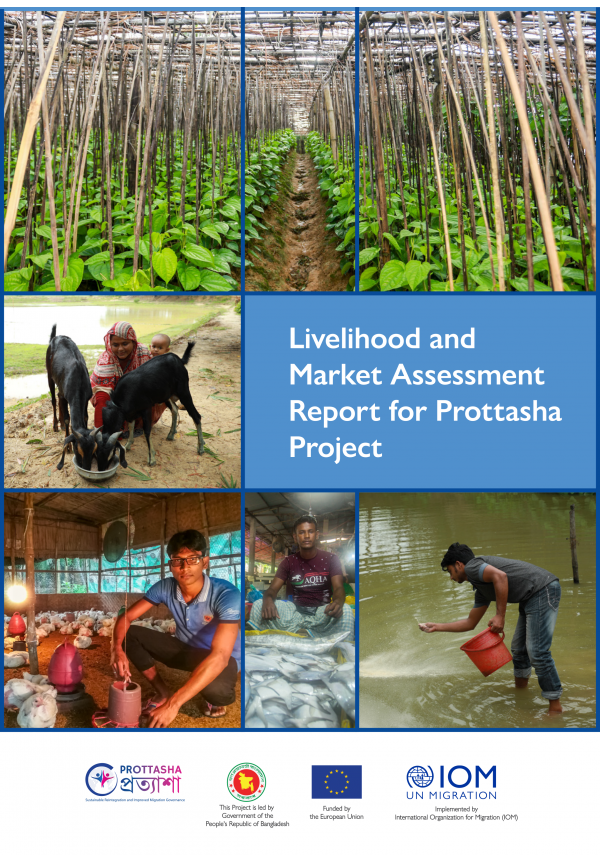
18 Dec 2020
Livelihood and Market Assessment Report for Prottasha Project
An integrated approach to economic reintegration of returning migrants requires identifying appropriate individual business and/or other livelihood opportunities that match their skills, experiences, backgrounds and aspirations. To provide individual or collective tailored economic reintegration support in order to ensure improved livelihoods and income opportunities for 3,000 Bangladeshi returning migrants from European Union countries, the Government-led project Bangladesh: Sustainable Reintegration and Improved Migration Governance – also known as the Prottasha project – is being implemented by IOM in partnership with BRAC, with financial support from the European Union.
This publication presents the results of a study conducted by IOM for the Prottasha project to identify suitable economic opportunities for the returnees in selected geographic locations, which would complement and supplement the livelihoods of the returnees. The study was conducted in four phases. First, a primary study was done to understand the returnees’ economic situations, resources, skills and vulnerabilities, among others. Then, a secondary study was carried out to develop understanding about the employment and business opportunities available in the localities where the returnees were based. Third, an in-depth quantitative study was done to identify employment and business opportunities appropriate for the returnees. Finally, to prioritize the economic opportunities that are aligned with the skills, experiences and interests of the target beneficiaries, and economic opportunities that will complement and supplement rather than substitute target beneficiaries’ existing livelihoods, a five-dimension matrix was applied as a methodological framework. The matrix helps to identify the most suitable businesses/economic opportunities for each selected location. Through this study, the Prottasha project could prioritize livelihood options for the returnees and streamline its activities and assistance to ensure economic reintegration of the returnees.
Read More
- List of tables
- List of figures
- Acronyms and abbreviations
- Executive summary
- 1. Introduction
- 1.1. Purpose of the study
- 1.2. Objectives of the study
- 2. Methodology
- 2.1. Survey site, sample size and sampling method
- 2.2. Survey procedure and data collection tools
- 2.3. Data analysis methodology
- 2.4. Limitations and challenges in data collection and the actual sample size
- 2.5. Ethical consideration
- 3. Beneficiary economic profile
- 3.1. Demographic profile
- 3.2. Education
- 3.3. Employment
- 3.4. Household income and expenditure
- 3.5. Skills
- 3.6. Household productive assets
- 3.7. Debt profile
- 4. District economic profile
- 4.1. Dhaka
- 4.2. Cumilla
- 4.3. Khulna
- 4.4. Munshiganj
- 4.5. Narshingdi
- 4.6. Noakhali
- 4.7. Shariatpur
- 4.8. Sirajganj
- 4.9. Sylhet
- 4.10. Tangail
- 5. Market assessment findings
- 5.1. Opportunities identified for community enterprises
- 5.2. Economic opportunity for individual assistance
- 5.3. Training and support services available for individual economic assistance
- 6. Conclusion
- 7. Annexes
- 7.1. Focus group discussion and key informant interview questionnaire
- 7.2. Benchmarking scoring tool
- 7.3. List of respondents for key informant interviews and focus group discussions